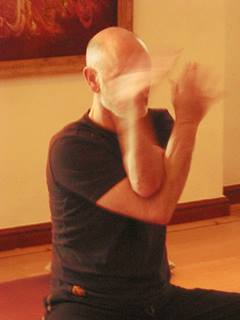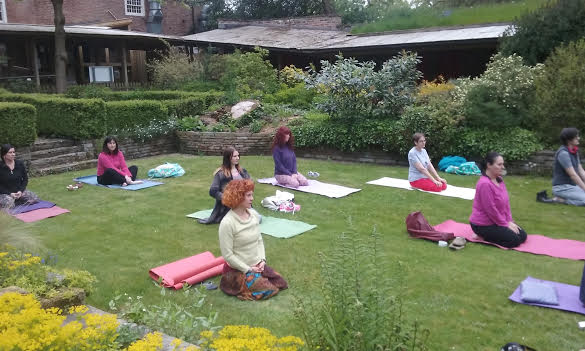How much are you Influenced by Fear?
Posted on
 The use of fear
The use of fear
Posted on
 The use of fear
The use of fear
Posted on

I have been a yoga teacher for about 15 years and in the early days most of the attendees were women. Well I might as well say, all the attendees were women. I can't really remember any men attending in the earlt 2000's. Then around 2010 there were a few men attending with wives and girlfriends mainly from curiosity or compulsion!
It's all strangely surprising when you consider that yoga all started with men, for men despite it's notionally being open to all humans. Still for many years it has appealed to women with men often seeing it as the soft option to exercise. Of course those who practice yoga know it is neither of those things. When you've tried some of the core postures you soon realize its not a soft option. Further more it's not strictly an "exercise". It is physical but with a different agenda.
Yoga is really about calming the aggitations of the mind through the body. As we know it's difficult to separate the body from the mind. Humans are somapsychic animals and yoga practice gives us the opportunity via a diverse range of postural positioning to work deeply with our muscles and soft tissue to release knots and tension so allowing us to deal better with pains and discomfort and provide a physical environment that allows us also to be mentally comfortable.
Even if you wish to avoid all the mental, emotional stuff of yoga there are physical bye products such as greater flexibility, toning and strength and more joint stability. This is great for sports people and sportsmen. Ryan Giggs the great Man United player swore it transformed his game and allowed him to avoid injury more and play into his 40's. There are also many other celebrities now turning to yoga both sports and none sports.
I said about avoiding the mental stuff and you can decide to do that but in reality your body won't let you. Over time regular yoga practice incorporating correct brathing and relaxation will naturally begin to quieten you down and bring greater calmness enabling you to see tensions and callenges coming earlier so you can deal with them and recovering from stress and emotional attacks more quickly.
In the last few years I've seen an increase in male attendance at classes. Just yesterday the majority of my students were men. Some come for physical reasons such as a compliment to their sport or sports injury recovery. Others to relieve stress from a pressurized job. Still others who are at a crossroads in their life and are seeking to engage better with their inner self - yoga can be "spiritual" but at the very least it is always self enquiring. The increase in male interest in yoga is great because it begins to signal that yoga is a beneficial practice for everyone and can only bring more harmony into the lives of both women and men.
Barry Todd (Yog Teacher/Trainer)
Posted on
- so .. as I have already planned some exciting dishes for tomorrow which has been cancelled and bought in a lot of the ingredients I have decided to make it tonight and let you into the secret so that you can enjoy it yourself if you want to.
I love cauliflower and I love curried cauliflower so I have created a dish that is not cauliflower cheese but is a good substitute with a bit more bite.
![]() ???? And by the way - if you are putting a lot of effort and care into preparing a dish why not make it organic.
???? And by the way - if you are putting a lot of effort and care into preparing a dish why not make it organic.
You will need a cauliflower cooked whole and trimmed
Here is what I did:
Gently fry some chopped onions and crushed garlic with a chopped red pepper (mine was donated from my friends garden), a little chopped fresh ginger, curry leaves, cumin seeds, a little powdered fennel (not too much as it is really sweet) any other herbs or spices that you feel right.
Add cashew nut milk and simmer for a while. Blend smooth. Then add some creamed cashew nuts (or any other kind of nut bearing in mind the milk you have used). At this stage I sprinkled a little tumeric into the pot - hence the colout. Stir until thickened. Season to taste.
Put the cauliflower in a dish and pour over the sauce. If you pour it slowly it gives time for the sauce to soak into the cauliflower. It tastes very yummy. Warm or brown in the oven if you need to.
Let me know if you try it. And those who were expecting to be eating tomorrow I hope this goes some way to compensating.
Posted on

In recent years there's been a lot of speculation about how long yoga teacher training courses should be. Perennially, we have had the 200 hour courses. Then some of the yoga associations began proposing 500 hour courses and then almost as an afterthought along came the 300 hour compromise from some yoga schools. Recently, we have been getting suggestions about a 1000 hours! Of course you could always opt for the 30 day fast track style course in some far flung exotic location but who would seriously fancy that!
So which is right?
I'm grasping here for the piece of string concept. There is a belief in learning circles that anyone wanting to become adept at any subject has to be looking at around 10,000 hours of application and of course this would take years. So we are moving towards the idea that the more you do the better you get and that's obvious of course.
There are a number of variable factors that ought to be considered when thinking of how long you initially train and what might help project you forward in your progress.
My first concern about extended training courses such as the 500 and possible 1000 hour courses is trainee commitment. Even the 200 hour courses can require a full weekend every month for a year with additional attendance for observed teaching practice and maybe assistance work plus added homework. Many of my trainees over the years have missed days and even whole weekends of their course despite signing to full commitment.
Some prospective trainees also have the hidden belief that a 200 hr course is a softish option and really just about attending the weekends when they can have an interesting interaction with like minded students and practice a bit of yoga with a bit of philosophy thrown in. It really depends on which 200 hour course you do and the syllabus is worth looking at and even asking the trainer what the course work is like and what to expect. Some 200hr courses are superficial and can be a bit like some of those in Australia where many 200 hr graduates are only expected to act as yoga teaching assistants.
There are 200hr courses that have a lot of depth and where the homework can be more demanding.Its often about striking a balance between exposing trainees to enough (probably 50%) practice and training with methodology and the philosophy, traditions and thinking behind yoga.
I insist that trainees do several of their later observed teaching practices with invited members of the public as this gives them a more realistic experience so they don't have to wait till after the course to teach "real people" as opposed to peer group teaching. My trainees are also preparing yoga sequences from month two and teaching their per group from month 3. Where appropriate I also encourage them to start teaching in the community if there is the opportunity and I think they are ready. This will depend on their confidence and early knowledge. Remember, insurance is needed and their students must be informed that they are on a training course and perhaps charge a bit less. In my experience those trainees who can find this opening (not always easy but doable) progress more quickly even if they start the course with less experinec than other trainees.
Also it's easier to get to grips more quickly with a teacher training course if you have first attended a short (6mnths) Yoga Foundation which is aimed at deepening your practice.
In conclusion I think the 200hr can be enough to be ready to teach if you apply yourself to the course work and do plenty of background reading while also considering some of the other factors I have mentioned above. It's worth noting that those who embark on a yoga teacher training course will no doubt have been personally practicing for some years and attending regular yoga classes weekly. This should give them a strong start especially if they have been getting their heads into yoga thinking behind the Yoga Sutras and other texts.
It's courses for horses so to speak and also how you work. Some people just like taking courses all their life. I have heard of someone who has taken no less than 6 yoga teacher training courses and this was while they reamined an assistant teacher! In the end you have to dip your toe in the water and find every opportunity to teach as this is what will make you strong. The course is really to propel you forward to that place.
Barry Todd (Hatha Teacher and Trainer)